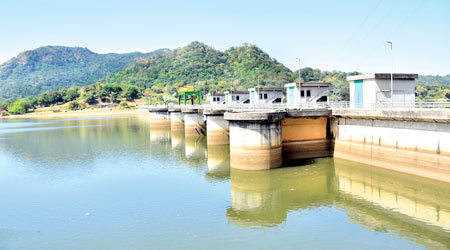|
El Nino's challenge:
Hoping of rains in April
by Dhaneshi Yatawara
Meteorologists said there is a possibility of a slight change in the
weather in the near future, reducing the dry weather that is prevailing
in the country.
 |
|
The depleting levels of
water at the Rantambe reservoir. |
There is a possibility of inter-monsoonal rains in April, despite the
continued dry weather, said S. Premalal, Director of Research, Training
and Development in the Meteorology Department. "It is only a prediction
and the weather is unpredictable," he said.
"Sri Lanka continues to experience a negative rainfall anomaly. The
condition, which in general terms means an unusual drop in the normal
rain which has affected Sri Lanka since January," he said.
The Meteorology Department report on the probabilities of receiving
rain in March, shows no signs of normal rain. The dry season of the
country seems to be getting drier.
Meteorologists said low rainfall was one of the main causes for the
unbearable heat, worsening the conditions of this usually dry and hot
season of the year. The sun shining close to the equator at this time of
the year adds to it.
"We cannot specify this as a drought, because a drought is a more
complicated condition. It is the dry season which has become drier," he
added.
Meteorologists do not rule out the effects of El Nino which is one of
the main factors which changes the circulation of air in the atmosphere
all around the world.
"We do not know the direct effect of El Nino on the North-East
monsoon, as no studies have been done so far. But the current El Nino
effect is strong and may affect the local weather pattern and its
effects cannot be ruled out," Premalal said.
Mitigation strategies
"There is an obvious change in the rain pattern which is a result of
the global climate change. Sri Lanka, like other countries, is facing
the consequences of a global phenomenon," he said.
 |
|
Parched river bed of the
Kotmale reservoir. |
"Sri Lanka and many more countries are ignorant about mitigation
strategies and that is not a comforting factor but a disaster," he said.
According to agroclimatologist Prof. Buddhi Marambe these were only
predictions and the actual situation may differ. "According to the
current data, the situation will be drier in the coming months," he
said.
"The Yala season, which is usually dry, will dry further,' he said.
The current change in the weather pattern seems to be making the dry
season drier and the wet seasons more damp, he added. He said the
climate change would affect the agriculture sector.
If the Yala season gets drier, there will be less water for
cultivation. "Farmers depending on irrigation water will have a problem
as there will be less water in the reservoirs. During the wet season, if
it rains at harvest time, it will have an adverse effect on
agriculture," he said.
Siltation and poor maintenance have limited the water-storing
capacity at most of these tanks.
The situation will be the same for vegetables and fruits, even though
it needs less water than paddy cultivation.
"To reduce the effect caused by the worsening weather, seasonal
weather forecasts need to reach more people to give confidence and
prepare for weather changes," he said.
According to the Sri Lanka Hazard Profile, compiled two years ago, 11
agro-ecological areas of the Dry Zone have a greater degree of facing
drought, while all the 20 agro-ecological areas of the Intermediate Zone
face moderate or high degree drought risk.
"This is going to be a difficult year," said Emeritus Prof. W.L
Sumathipala, former head of the Sri Lankan Climate Change Secretariat.
Altered weather patterns could be coupled with global temperature rise
due to climate change, he said.
Torrential rains
"Sri Lanka is unlikely to get her share of rain. The reason for the
weather being the El Nino over the Pacific ocean," he said.
"Last year and this year are El Nino years. We cannot expect the
heavy inter- monsoonal rains in March and April. With increasing global
warming, the El Nino effect in the future can be stronger. Even to date
the El Nino has become stronger in the recent past," Prof. Sumathipala
said.
How can atmospheric changes over the Pacific ocean affect Sri Lanka
in the Indian ocean, passing a land barrier (maritime continent) formed
by the South East Asian countries? "These environments are
atmospherically linked," he explained. South East Asian countries such
as Malaysia, Singapore and Indonesia, which usually experience
torrential rains, dry up due to the El Nino effect. Countries on the
Eastern Pacific side, such as Chile and Peru, which usually experience
dry weather will be soaked in rain.
Islands such as Sri Lanka and the Maldives, which never experienced
heat waves due to its geography, may face such consequences in the
future. "There are heat waves in continents. Countries such Sri Lanka
are islands and have environment conditions reducing heat waves. But
with the current changes these countries may face changes too," he said.
"The extreme dry season has followed the continuous wet season as
predicted. There needs to be preparedness in the society in all sectors
to avoid long-term adverse effects on the people," he said. |

